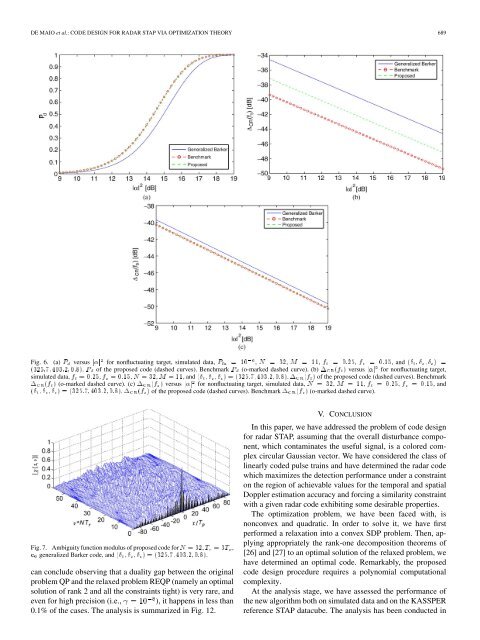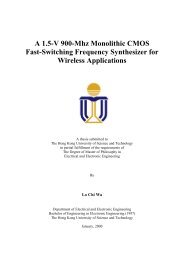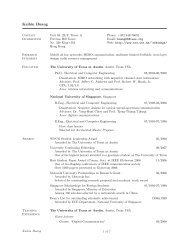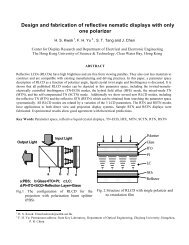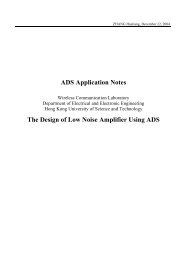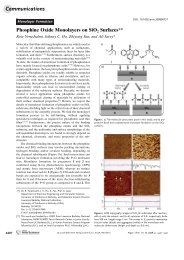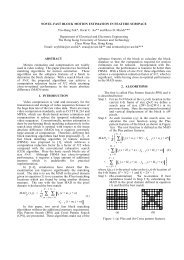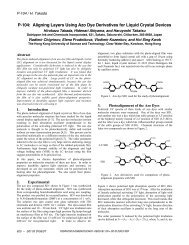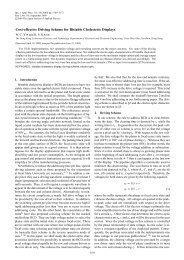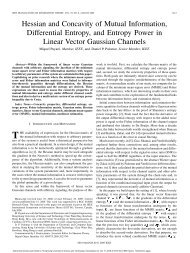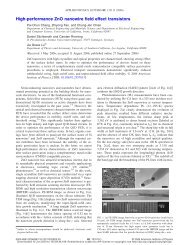688 IEEE TRANSACTIONS ON SIGNAL PROCESSING, VOL. 58, NO. 2, FEBRUARY 2010Fig. 5. (a) Ambiguity function modulus of code which maximizes the SINR <strong>for</strong> N =32, T =3T , =0:5, =3:8, c generalized Barker code, and =0:9957. (b) Ambiguity function modulus of code which maximizes the SINR <strong>for</strong> N =32, T =3T , =0:5, =3:8, c generalized Barker code,and =0:9918. (c) Ambiguity function modulus of code which maximizes the SINR <strong>for</strong> N =32, T =3T , =0:5, =3:8, c generalized Barker code,and =0:9811. (d) Ambiguity function modulus of code which maximizes the SINR <strong>for</strong> N =32, T =3T , =0:5, =3:8, c generalized Barkercode, and = 0.In Fig. 10(b), we plot , , andversus <strong>for</strong> the same values of the parameters consideredin the previous figure. The curves highlight that increasinglower and lower values can be achieved.Finally, in Fig. 11, we plot versus <strong>for</strong> nonfluctuatingtarget, , , and <strong>for</strong> several values of . We cannotice that the closer to 1, the closer to , namely theper<strong>for</strong>mances of the proposed code and the generalized Barkercode end up coincident.In conclusion, , , and exhibit a similarbehavior both with simulated and KASSPER covariance data.Moreover, the proposed analysis shows that it is possible to realizea tradeoff among the three parameters , , and to increasethe detection per<strong>for</strong>mance, or to improve the Doppler estimationaccuracy, or to shape the ambiguity function.C. Occurrence of Subcase 3.2In this subsection, we analyze the typical rank of an optimalsolution of the SDP problem REQP. First of all, we have todeal with the finite precision of MATLAB implementation of theencoding algorithm. To this end, we introduce thefunction, namely the number of eigenvalues of the matrixgreater than the positive threshold . For a positive semidefinitematrix , represents a good numerical estimation ofthe rank of ,as . Moreover, we have to distinguish a tightconstraint from a strict constraint. In this case, we consider theconstraint as practically tight if the difference of the two sides ofthe inequality is less than . Per<strong>for</strong>ming 10 000 instances of theproblem REQP (with clutter covariance matrix from the rangecell number 10 of the KASSPER datacube, , ,, , generalized Barker sequence, , ,and randomly chosen), 5 in less than 1% of the cases, we getan optimal solution with . For those particularsituations, we have also controlled the constraints, and in lessthan 10% of the cases, we have all the three constraints practicallytight (namely, case 3.2 described in Section III). Summarizing,in less than 0.1% of the instances, we have a suboptimalsolution of the original QP problem. This trend holds <strong>for</strong>all the considered values of the parameter . 6 Furthermore, mostof the instances presents a, even if the numberdecreases as the precision tends to 0 (and consequently theoccurrence of the eventincreases). Thus, we5 is a uni<strong>for</strong>mly distributed random variable in the interval[ (R ); (R )], in [ (R ); (R )], and in [0;1], with (1) representing the minimum eigenvalue of the argument.6 Notice that additional results obtained changing M and c randomly in the10 000 experiments also agree with the a<strong>for</strong>ementioned behavior.
DE MAIO et al.: CODE DESIGN FOR RADAR <strong>STAP</strong> VIA OPTIMIZATION THEORY 689Fig. 6. (a) P versus jj <strong>for</strong> nonfluctuating target, simulated data, P = 10 , N = 32, M = 11, f = 0:25, f = 0:15, and ( ; ; ) =(325:7; 403:2; 0:8). P of the proposed code (dashed curves). Benchmark P (o-marked dashed curve). (b) 1 (f ) versus jj <strong>for</strong> nonfluctuating target,simulated data, f =0:25, f =0:15, N =32, M =11, and ( ; ; ) = (325:7; 403:2; 0:8). 1 (f ) of the proposed code (dashed curves). Benchmark1 (f ) (o-marked dashed curve). (c) 1 (f ) versus jj <strong>for</strong> nonfluctuating target, simulated data, N = 32, M = 11, f = 0:25, f = 0:15, and( ; ; ) = (325:7; 403:2; 0:8). 1 (f ) of the proposed code (dashed curves). Benchmark 1 (f ) (o-marked dashed curve).Fig. 7. Ambiguity function modulus of proposed code <strong>for</strong> N =32, T =3T ,c generalized Barker code, and ( ; ; ) = (325:7; 403:2; 0:8).can conclude observing that a duality gap between the originalproblem QP and the relaxed problem REQP (namely an optimalsolution of rank 2 and all the constraints tight) is very rare, andeven <strong>for</strong> high precision (i.e., ), it happens in less than0.1% of the cases. The analysis is summarized in Fig. 12.V. CONCLUSIONIn this paper, we have addressed the problem of code design<strong>for</strong> radar <strong>STAP</strong>, assuming that the overall disturbance component,which contaminates the useful signal, is a colored complexcircular Gaussian vector. We have considered the class oflinearly coded pulse trains and have determined the radar codewhich maximizes the detection per<strong>for</strong>mance under a constrainton the region of achievable values <strong>for</strong> the temporal and spatialDoppler estimation accuracy and <strong>for</strong>cing a similarity constraintwith a given radar code exhibiting some desirable properties.The optimization problem, we have been faced with, isnonconvex and quadratic. In order to solve it, we have firstper<strong>for</strong>med a relaxation into a convex SDP problem. Then, applyingappropriately the rank-one decomposition theorems of[26] and [27] to an optimal solution of the relaxed problem, wehave determined an optimal code. Remarkably, the proposedcode design procedure requires a polynomial computationalcomplexity.At the analysis stage, we have assessed the per<strong>for</strong>mance ofthe new algorithm both on simulated data and on the KASSPERreference <strong>STAP</strong> datacube. The analysis has been conducted in


